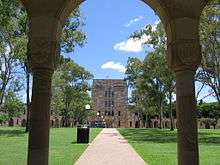University of Queensland
The University of Queensland (UQ) is a public research university located primarily in Brisbane, the capital city of the Australian state of Queensland. Founded in 1909 by the state parliament, UQ is classed as one of the six sandstone universities, an informal designation of the oldest university in each state.[6] The University of Queensland is ranked second nationally by Excellence in Research for Australia and equal second in Australia based on the average of four major global university league tables.[7] The University of Queensland is a founding member of edX, Australia's research-intensive Group of Eight, the international research network McDonnell International Scholars Academy,[8][9] and the global Universitas 21 network.[10]
.svg.png) Coat of arms of the University of Queensland | |
| Latin: Terrae Reginae Universitas[1] | |
| Motto | Scientia ac Labore (Latin) |
|---|---|
Motto in English | By means of knowledge and hard work |
| Type | Public research university |
| Established | 1909 |
| Endowment | A$224.3 million[2] |
| Budget | A$2.1 billion[3] |
| Chancellor | Peter Varghese |
| Vice-Chancellor | Deborah Terry |
Academic staff | 2,854 (FTE, 2019)[4] |
| Students | 53,696 (2019)[4] |
| Undergraduates | 35,076 (2019)[4] |
| Postgraduates | 18,620 (2019)[4] |
| Location | Brisbane, Queensland, Australia 27°29′50″S 153°0′47″E |
| Campus | International, urban and regional 1,463 hectares (3,620 acres) |
| Colours | Maroon and sky blue Purple |
| Affiliations | Group of Eight Universitas 21 ASAIHL EdX McDonnell International Scholars Academy[5] |
| Website | uq |
 | |
The main St Lucia campus occupies much of the riverside inner suburb of St Lucia, southwest of the Brisbane central business district. Other UQ campuses and facilities are located throughout Queensland, the largest of which are the Gatton campus and the Mayne Medical School. UQ's overseas establishments include UQ North America office in Washington D.C., and the UQ-Ochsner Clinical School in Louisiana, United States.
The university offers associate, bachelor, master, doctoral, and higher doctorate degrees through a college, a graduate school, and six faculties. UQ incorporates over one hundred research institutes and centres, such as the Institute for Molecular Bioscience, Boeing Research and Technology Australia Centre,[11] the Australian Institute for Bioengineering and Nanotechnology, and the UQ Dow Centre for Sustainable Engineering Innovation.[12] Recent research achievements of the university include pioneering the invention of the HPV vaccine that prevents cervical cancer, developing a COVID-19 vaccine currently in human trials[13] and the development of high-performance superconducting MRI magnets for portable scanning of human limbs.[14]
UQ counts two Nobel laureates (Peter C. Doherty and John Harsanyi), over a hundred Olympians winning numerous gold medals[15] and 117 Rhodes Scholars[16] among its alumni and staff. UQ's alumni also include the President of the University of California San Francisco Sam Hawgood, the first female Governor-General of Australia Dame Quentin Bryce, President of King's College London Ed Byrne, member of United Kingdom's Prime Minister Council for Science and Technology Max Lu, Oscar and Emmy awards winner Geoffrey Rush, triple Grammy Award winner Tim Munro, former Chief Justices of Australia, and the former CEO and Chairman of Dow Chemical and current Director of DowDuPont Andrew N. Liveris.
History
Foundation of the university
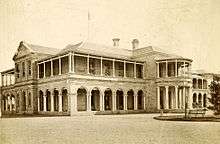
Proposals for a university in Queensland began in the 1870s. A royal commission in 1874, chaired by Sir Charles Lilley, recommended the immediate establishment of a university. Those against a university argued that technical rather than academic education was more important in an economy dominated by primary industry. Those in favour of the university, in the face of this opposition, distanced themselves from Oxford and Cambridge and proposed instead a model derived from the mid-western states of the United States. A second royal commission in 1891 recommended the inclusion of five faculties in a new university; arts, law, medicine, science and applied science. Education generally was given a low priority in Queensland's budgets, and in a colony with a literacy rate of 57% in 1861, primary education was the first concern well ahead of secondary and technical education. The government, despite the findings of the royal commissions, was unwilling to commit funds to the establishment of a university.[17]
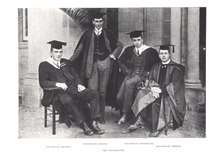
In 1893, the Queensland University Extension Movement was begun by a group of private individuals who organised public lecture courses in adult education, hoping to excite wider community support for a university in Queensland. In 1894, 245 students were enrolled in the extension classes and the lectures were described as practical and useful. In 1906 the University Extension Movement staged the University Congress, a forum for interested delegates to promote the idea of a university. Opinion was mobilised, a fund was started and a draft bill for a Queensland university was prepared. Stress was laid on the practical aspects of university education and its importance for the commerce of Queensland. The proceedings of the congress were forwarded to the Premier of Queensland, William Kidston. In October 1906, sixty acres in Victoria Park were gazetted for university purposes.[17]
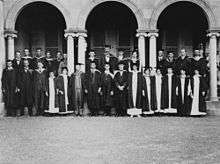
The University of Queensland was established by an act of state parliament on 10 December 1909 to commemorate the 50th anniversary of Queensland's separation from the colony of New South Wales. The act allowed for the university to be governed by a senate of 20 men and Sir William MacGregor, the incoming governor, was appointed the first chancellor with Reginald Heber Roe as the vice-chancellor. Government House (now Old Government House) in George Street was set aside for the university following the departure of the governor to the Bardon residence, Fernberg, sparking the first debates about the best location for the university.[17]
In 1910 the first teaching faculties were created. These included engineering, classics, mathematics and chemistry. In December of the same year, the senate appointed the first four professors; Bertram Dillon Steele in chemistry, John Lundie Michie in classics, Henry James Priestley in mathematics and Alexander James Gibson in engineering. In 1911 the first students enrolled.[17] The university's first classes in the Government House were held in 1911 with 83 commencing students and Sir William MacGregor is the first chancellor (with Reginald Heber Roe as vice-chancellor). The University of Queensland began to award degrees to its first group of graduating students in 1914.[18]
1920s to 1990s
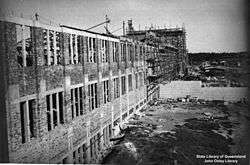
The development of the university was delayed by World War I, but after the first world war the university enrolments for education and research took flight as demand for higher education increased in Australia. Thus, in the early 1920s the growing university had to look for a more spacious campus as its original site in George Street, Brisbane, had limited room for expansion.[6] In 1927, James O'Neil Mayne and his sister, Mary, provided a grant of approximately £50,000 to the Brisbane City Council to acquire 274 acres (111 ha) of land in St Lucia and provided it to the University of Queensland as its permanent home. In the same year, the pitch drop experiment was started by Thomas Parnell. The experiment has been described as the world's oldest and continues to this day.[19] Lack of finance delayed development of the St Lucia campus. Hence, the construction of the university's first building in St Lucia only began in 1938. It was later named the Forgan Smith Building, after the premier of the day and it was completed in 1939. During World War II, the Forgan Smith Building was used as a military base and it served first as advanced headquarters for the Allied Land Forces in the South West Pacific.[6]
The first Doctor of Science was awarded in 1942.[21] The first PhD was awarded in 1952.[22][23]
1990s to present day
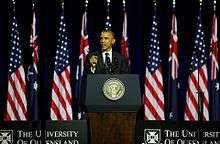
In 1990, Australia reorganised its higher education system by abolishing the binary system of universities and colleges of advanced education. Under this transition, the university merged with Queensland Agricultural College, to establish the new UQ Gatton campus. In 1999, UQ Ipswich began operation as one of the completely Web-enabled campuses in Australia.[6][25]
In 2010, the University of Queensland was a recipient of the Queensland Greats Awards.[26]
In May 2013, UQ joined edX, an international consortium of massive open online courses (MOOCs). From May 2014, the initial four UQx courses cover hypersonics, tropical coastal ecosystems, biomedical imaging and the science of everyday thinking.[27]
Organisation and administration
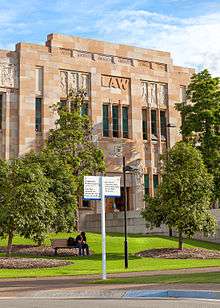
The University of Queensland is organised into a number of divisions for academic, administrative and logistical purposes.[28]
Governance
The senate is the governing body of the University of Queensland and consists of 22 members from the university and community. The senate is led by the chancellor and deputy chancellor, elected by the senate. The University of Queensland Act 1998 grants the senate wide powers to appoint staff, manage and control university affairs and property and manage and control finances to promote the university's interests.[29][30]
- Provost
- Deputy Vice-Chancellor (Academic)
- Deputy Vice-Chancellor (External Engagement)
- Deputy Vice-Chancellor (Research)
- Pro-Vice-Chancellor
- Pro-Vice-Chancellor (Advancement)
- Pro-Vice-Chancellor (Indigenous Engagement)
- Pro-Vice-Chancellor (Research)
- Pro-Vice-Chancellor (Research Infrastructure)
- Pro-Vice-Chancellor (Research Partnerships)
- Pro-Vice-Chancellor (Research Training)
- Pro-Vice-Chancellor (Teaching and Learning)
- Chief Operating Officer
- President of the Academic Board
The academic board is the university's senior academic advisory body. It formulates policy on academic matters including new programs, teaching, learning and assessment, research, promotions, student academic matters, prizes and scholarships. An academic board member is elected annually as its president. The president is assisted by a half-time deputy president.[31]
Academic faculties
The university has six faculties to support both research and teaching activities.
Faculty of Business, Economics and Law
- School of Business
- School of Economics
- School of Law
Faculty of Engineering, Architecture and Information Technology
- School of Architecture
- School of Chemical Engineering
- School of Civil Engineering
- School of Information Technology and Electrical Engineering
- School of Mechanical and Mining Engineering
Faculty of Health and Behavioural Sciences
- School of Dentistry
- School of Health and Rehabilitation Sciences
- School of Human Movement and Nutrition Sciences
- School of Nursing, Midwifery and Social Work
- School of Pharmacy
- School of Psychology
Faculty of Humanities and Social Sciences
- School of Communication and Arts
- School of Education
- School of Historical and Philosophical Inquiry
- School of Languages and Cultures
- School of Music
- School of Political Science and International Studies
- School of Social Science
Faculty of Medicine
- School of Biomedical Sciences
- School of Public Health
Faculty of Science
- School of Agriculture and Food Sciences
- School of Biological Sciences
- School of Chemistry and Molecular Biosciences
- School of Earth and Environmental Sciences
- School of Mathematics and Physics
- School of Veterinary Science
UQ has a semester-based modular system for conducting academic courses. The Australian higher education model features a combination of the British system, such as small group teaching (tutorials) and the American system (course credits).
Finances
Over a decade, UQ received more than $200 million in additional revenue from billionaire Chuck Feeney’s Atlantic Philanthropies, which matched funding with the Beattie government’s Smart State program.[32]
Academic profile
International Partnerships
Today UQ has a number of agreements in place for with many of the world's leading universities, including: Princeton University, University of Pennsylvania, University of California, University of Toronto, McGill University, University of British Columbia, Imperial College London, University College London, University of Edinburgh, Balsillie School of International Affairs, Sciences Po, Ludwig Maximilians Universität Munich, University of Zürich, University of Auckland, National University of Singapore, Nanyang Technological University, Peking University, University of Hong Kong, University of Tokyo, National Taiwan University, and Seoul National University.[33]
Rankings
| University rankings | |
|---|---|
| The University of Queensland | |
| QS World[34] | 46 |
| THE-WUR World[35] | 66 |
| ARWU World[36] | 54 |
| USNWR World[37] | 42 |
| CWTS Leiden World[38] | 31 |
| Australian rankings | |
| QS National[34] | 5 |
| THE-WUR National[39] | 4 |
| ARWU National[40] | 2 |
| USNWR National[41] | 3 |
| CWTS Leiden National[38] | 1 |
| ERA National[42] | 2 |
| Select QS Global Subject Rankings[43] | |||
|---|---|---|---|
| Program | Ranking | ||
| Accounting & Finance | 41 | ||
| Agriculture & Forestry | 25 | ||
| Anthropology | 43 | ||
| Biological Sciences | 44 | ||
| Business & Management | 83 | ||
| Chemical Engineering | 38 | ||
| Earth & Marine Sciences | 44 | ||
| Economics & Econometrics | 81 | ||
| English Language and Literature | 48 | ||
| Environmental Sciences | 14 | ||
| Education | 23 | ||
| Hospitality & Leisure Management | 23 | ||
| Law | 39 | ||
| Life Sciences and Medicine | 37 | ||
| Mathematics | 88 | ||
| Mineral & Mining Engineering | 5 | ||
| Nursing | =36 | ||
| Pharmacy & Pharmacology | 31 | ||
| Physics & Astronomy | 129 | ||
| Politics & International Studies | 74 | ||
| Psychology | 23 | ||
| Sociology | 36 | ||
| Sports-Related Subjects | 3 | ||
| Veterinary Science | =28 | ||
| THE Global Subject Rankings[44] | |||
|---|---|---|---|
| Program | Ranking | ||
| Clinical, Pre-Clinical and Health | 66 | ||
| Life Sciences | 42 | ||
| Physical Sciences | 114 | ||
| Psychology | 47 | ||
| Business and Economics | =55 | ||
| Education | =46 | ||
| Law | 58 | ||
| Social Sciences | =69 | ||
| Engineering and Technology | =94 | ||
| Computer Science | 117 | ||
| Arts and Humanities | 89 | ||
When averaging the world's major rankings, The University of Queensland is ranked equal second in Australia, together with University of Sydney and Australian National University.[7] UQ is ranked 42nd in the world by the 2020 US News Global Ranking,[45] 54th in the world in the Academic Ranking of World Universities 2019,[46] 46th in the world in the QS World University Rankings,[47] and 66th in the world in the Times Higher Education World University Rankings 2020.[48] UQ is ranked 32nd in the world and 1st in Australia in the CWTS Leiden Ranking 2019 when using the P(top 1%) indicator.[49][50][51] Scimago Institutions Rankings (Higher Education) has UQ ranked at 41st in the world and 3rd in Australia for 2019.[52]
Subject
Overall, UQ Business School's Master of Business Administration degree is ranked first in Asia Pacific and top 10 globally in The Economist Intelligence Unit 2016 MBA ranking.[53] UQ's MBA degree is ranked 1st in Australia by the Australian Financial Review.[54] UQ is also the top Australasian institution for life sciences in the U.S. News & World Report and the Academic Ranking of World Universities.[55][56]
The university is also highly ranked in various engineering disciplines. In mining and minerals engineering, it stands in 3rd worldwide, in chemical engineering 76–100th worldwide, in civil engineering 76–100nd worldwide, in material science and engineering 101–150th worldwide, and in electrical and electronic engineering it is ranked within 101–150th worldwide.[57]
In the Center for World University Rankings (CWUR) inaugural world subject rankings, UQ ranked first in Biodiversity Conservation,[58] and top 10 in 13 subjects[59] based on the numbers of research articles published in top-tier journals.[60]
In the QS World University Rankings by Subject 2020, UQ ranked in the top 50 in the world in 21 subjects,[61] and first in Australia for Agriculture and Forestry;[62] Environmental Sciences.[63] and Sports-Related Subjects .[64]
Research
Queensland has a strong research focus in science, medicine and technology. The university's research advancement includes pioneering the development of the cervical cancer vaccines, Gardasil and Cervarix, by UQ Professor Ian Frazer.[65] In 2009, the Australian Cancer Research Foundation reported that UQ had taken the lead in numerous areas of cancer research.[66]
In 2010, Thomson Reuters named eight UQ professors to its list of Highly Cited Researchers.[67] In the Commonwealth Government's Excellence in Research for Australia 2012 National Report,[68] UQ's research is rated above world standard in more broad fields than at any other Australian university (in 22 broad fields), and more UQ researchers are working in research fields that ERA has assessed as above world standard than at any other Australian university. UQ research in biomedical and clinical health sciences, technology, engineering, biological sciences, chemical sciences, environmental sciences, and physical sciences was ranked above world standard (rating 5).
In 2015, UQ is ranked by Nature Index as the research institution with the highest volume of research output in both interdisciplinary journals Nature and Science within the southern hemisphere, with approximately twofold more output than the global average.[69]
Aside from disciplinary-focused teaching and research within the academic faculties, the university maintains a number of interdisciplinary research institutes and centres at the national, state and university levels.[70] For example, the Asia-Pacific Centre for the Responsibility to Protect, the University of Queensland Seismology Station, Heron Island Research Station and the Institute of Modern Languages.
With the support from the Queensland Government, the Australian Government and major donor The Atlantic Philanthropies, the University of Queensland dedicates basic, translational and applied research via the following research-focused institutes:
- Institute for Molecular Bioscience – within the Queensland Bioscience Precinct which houses scientists from the Commonwealth Scientific and Industrial Research Organisation[71] and the Community for Open Antimicrobial Drug Discovery
- Translational Research Institute, which houses The University of Queensland's Diamantina Institute, School of Medicine and the Mater Medical Research Institute
- Australian Institute for Bioengineering and Nanotechnology
- Institute for Social Science Research
- Sustainable Mineral Institute
- Global Change Institute
- Queensland Alliance for Environmental Health Science
- Queensland Alliance for Agriculture and Food Innovation
- Queensland Brain Institute
- Centre for Advanced Imaging[72]
- Boeing Research and Technology Australia Centre[73]
- UQ Dow Centre[74]
The University of Queensland plays a key role in Brisbane Diamantina Health Partners, Queensland's first academic health science system. This partnership currently comprises Children's Health Queensland, Mater Health Services, Metro North Hospital and Health Service, Metro South Health, QIMR Berghofer Medical Research Institute, Queensland University of Technology, The University of Queensland and the Translational Research Institute.[75]
Commercialisation and entrepreneurship
UniQuest is the main commercialisation company of the University of Queensland and specialises in global technology transfer and facilitates access for all business. UniQuest has created over 100 startups from its intellectual property portfolio, and since 2000 UniQuest and its start-ups have raised more than $700 million to take university technologies to market. UQ technologies licensed by UniQuest include UQ's cervical cancer vaccine technology, image correction technology in magnetic resonance imaging machines, and the Triple P Positive Parenting Program.[76]
Student life
The University of Queensland maintains a number of support and student services. The campuses at St Lucia and Gatton have Student Centres which provide information and support services.[77]
UQ Union
The UQ Union is the peak student representation body that coordinates various student services and activities, including over 190 affiliated clubs and societies, some of whom are listed below.
- Semper Floreat
- University of Queensland Australian Football Club
- University of Queensland Debating Society (UQDS)
- University of Queensland Football Club
- Queensland University Regiment
- University of Queensland Rugby Club
UQ Sport

UQ Sport offers a wide range of sport, fitness and recreation opportunities at the St Lucia and Gatton campuses of The University of Queensland. Its facilities and services are open to students, staff, alumni, and the general public.[78]
The UQ Aquatic Centre is operated by UQ Sport and consists of three pools; 50-metre and 25-metre outdoor heated pools and a small enclosed heated teaching pool. The main pool is a 50m lap pool with a minimum of three lanes dedicated to public lap swimming throughout the opening hours.
The UQ Athletics Centre maintains an Olympic standard 8 lane synthetic track and grandstand able to accommodate up to 565 spectators.[79] The UQ Sport and Fitness Centre is a multi-purpose indoor facility.[80]
The UQ Tennis Centre is the largest tennis centre in both Brisbane and Queensland.[81] The UQ Playing Fields and Ovals is also managed by UQ Sport, home to a total of eight oval fields at the St Lucia campus. The majority are designated for use by particular sports including cricket, rugby and soccer. These ovals are also used for recreational activities and lunchtime social sport.[82]
Australia's largest university based sailing club, The University of Queensland Sailing Club, also operates under UQ Sport. However, the sailing club mainly operates off-site at a private facility in Redcliffe.[83]
Events and traditions
Three Minute Thesis In 2008, the university originated the Three Minute Thesis competition for students completing a higher degree by research. Three Minute Thesis is now held annually at universities across Australasia. It challenges participants to present their research in just 180 seconds, in an engaging form that can be understood by an intelligent audience with no background in the research area. This exercise develops presentation, research and academic communication skills and supports the development of research students' capacity to explain their work effectively.[84]
Great Court Race
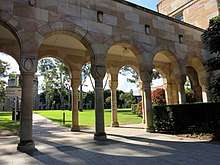
Inspired by the Trinity College Great Court Run of the University of Cambridge, the University of Queensland organises an annual 636m sprint race around the UQ sandstone Great Court.[85][86]
Market Day During Orientation week and the first week of each semester, Market Day is organised throughout Campbell Place and the Great Court at the St Lucia Campus. The UQ Union and clubs and societies have stalls and organises social activities.[87] Several clubs also organize large displays. For example, the University of Queensland Sailing Club is known for placing a sailing boat in the Great Court.[88]
Careers Fair The UQ Careers Fair is an annual event that brings together university students and major employers from across the country.[89] Degree-specific Careers Fairs are also held annually or bi-annually, such as the Engineering Careers Expo.[90]
Residential colleges
The University of Queensland has 11 residential colleges with 10 of these located on its St Lucia campus and one on its Gatton campus. The University of Queensland Intercollege Council is the organisational and representative body for the residential colleges which coordinates sporting and cultural events and competitions.
- Cromwell College is a co-ed college founded in 1950. It is affiliated with the Uniting Church and accommodates 249 students.
- Duchesne College is a women's only college founded in 1937 in Toowong, moving the university in 1959. It is affiliated with the Society of the Sacred Heart and accommodates 210 students.
- Emmanuel College is a co-educational college founded in 1911. It accommodates 340 students.
- Gatton Halls of Residence was established in 1897 and has 440 residential students, making it by far the largest and oldest college at the University.
- Grace College is a women's college founded in 1970. It accommodates 181 students.
- International House is a co-educational college for International and Australian students founded in 1965.
- King's College provides accommodation for 320 male and female students of the University.
- St John's College is a co-educational college founded in 1911. It is administered by the Anglican Diocese of Brisbane.
- St Leo's College is a men's college affiliated with the Roman Catholic Archdiocese of Brisbane.
- Union College is a co-educational, secular college named after the student union. It is listed on the Queensland Heritage Register.[91]
- Women's College is a college for female students.[92]
Campuses and facilities
The University of Queensland maintains a number of campuses and facilities throughout Queensland.[93][94] UQ has its main campus in the suburb of St Lucia in Brisbane, bordered by a meander in the Brisbane River to the north, east, and south. UQ's main campus has been recognised for its beauty by a number of sources.[95][96] Its other campuses include Gatton and Herston.
St Lucia campus
In 1927, the land on which the St Lucia campus is built was resumed by the Brisbane City Council using money donated by James O'Neil Mayne and his sister Mary Emelia Mayne to replace the less spacious city campus. The city campus is now home to the Gardens Point campus of the Queensland University of Technology. Construction of the new university at St Lucia began in 1937.[97]
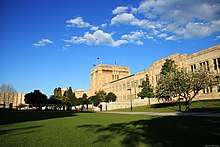
Great Court
At its centre is the heritage-listed Great Court – a 2.5 hectares (6.2 acres) open area surrounded by Helidon sandstone buildings with grotesques of great academics and historic scenes, floral and faunal motifs and crests of universities and colleges from around the world.[97] This central semi-circular quadrangle features a connected arcade so students could reach any section under cover. The Great Court was added to the Queensland Heritage Register in 2002.[98]
Museums
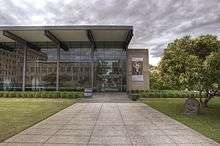
The University of Queensland Art Museum is located in the James and Mary Emelia Mayne Centre on the St Lucia campus. The Art Museum was established in the Forgan Smith Tower in 1976 to house the artworks collected by The University of Queensland since the 1940s, relocating to its present site in 2004. Today, with more than 4,400 artworks, the University's Art Collection is Queensland's second largest public art collection.[100]
The university also houses the R.D. Milns Antiquities Museum[101] in the Michie building (bldg 9, level 2) which contains Queensland's only publicly accessible collection of antiquities from ancient Rome, Greece, Egypt and the Near East. The museum supports research and teaching at the university.[102] The UQ Anthropology museum (also in the Michie Building on level 1) contains a significant collection of ethnographic material. It is also open to the public.[103]
Gatton campus
The UQ Gatton Campus covers 1068ha at Lawes, near the town of Gatton, Queensland, about 90 kilometres (56 mi) west of Brisbane on the Warrego Highway. The campus was opened in 1897 next to the site of the Queensland Agricultural College which was then amalgamated with UQ in 1990.[6] UQ Gatton is the core campus for research, learning and teaching activities and facilities in agriculture, animals, veterinary science and the environment.[104]
In 2008 the Centre for Advanced Animal Science (CAAS) was opened at the Gatton campus – a collaborative venture between UQ and the Queensland Government.[105]
Herston campus
UQ Mayne Medical School and the Queensland Institute of Medical Research is the core campus for clinical health teaching and research. The campus is situated in Herston and operates within Queensland Health system of the Royal Brisbane Hospital, Royal Children's Hospital, Royal Women's Hospital and the Queensland Institute of Medical Research.
It is home to the Faculty of Medicine, the School of Population Health, the Herston Health Sciences Library, the Centre for Clinical Research and clinical research and learning activities of the School of Nursing and Midwifery. The Herston campus also houses other key facilities such as the Oral Health Centre and the purpose-built Herston Imaging Research Facility. The medical school building was added to the Queensland Heritage Register in 1999.[17]
The Marks-Hirschfeld Museum of Medical History is in the Mayne Medical School at the Herston campus. Operated by volunteers and supported by the University of Queensland Alumni, it has a collection of over 7,000 items of medical memorabilia, medical and surgical instruments. The focus is on the study of medical history in Queensland, but the collection includes items with broader significance to Australia and internationally.[106][107]
- Overseas Clinical Schools
- Louisiana, United States – the UQ-Ochsner Clinical School operates at Ochsner Medical Center, New Orleans and Baton Rouge, allowing medical school students from the UQ-Ochsner program to receive two years of overseas clinical experience, contributing towards their UQ Doctor of Medicine (MD) degree.[108]
Ipswich campus
In 2014, UQ sold the Ipswich Campus to the University of Southern Queensland, believing that this regional teaching campus would be better used by USQ.[109]
The campus was made up of nearly 20 buildings and more than 5001 students on nearly 25 hectares (62 acres).[110] Courses offered included: arts, business, medicine and social sciences as well as Interaction design. It is located near central Ipswich, Queensland, just south of the CBD. Nearby landmarks include Limestone Park, Workshops Rail Museum and RAAF Base Amberley.
The site dates back to 1878 with the opening of the Ipswich branch of the Woogaroo Lunatic Asylum. Operations continued until 1910 when it became the Ipswich Hospital for the Insane.[110] In 1938 it was renamed the Ipswich Mental Hospital and in 1964 it was renamed again as the Ipswich Special Hospital. It was finally named the Challinor Centre in 1968 in honour of Henry Challinor, the ship's surgeon on the Fortitude. From 1968 to 1997 the Challinor Centre served as an institution for people with intellectual disabilities. In late 1997 the Challinor Centre began its first stage of transformation as the new UQ Ipswich campus.[110]
Satellite teaching and research centres
UQ has other research and education facilities not directly attached to its three campuses. These locations are primarily for research, which cannot be undertaken in the campus locales but also represent buildings which established pre-eminence in education before the creation of the current campuses.
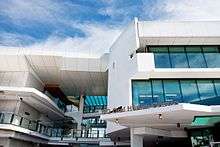
- Queen Street
Queen Street, Brisbane is the location of the Customs House and the UQ Business School Downtown Venue. Customs House is one of Brisbane's heritage icons and is located on the river along Queen Street in the Brisbane central business district. It is leased to and operated by the University of Queensland as a cultural, educational and heritage facility.[111] The UQ Business School Downtown is an inner-city corporate education, meeting and dining venue and facility which is on Level 19 of Central Plaza One in the Brisbane central business district.
- Indooroopilly
Indooroopilly is the site of the Julius Kruttschnitt Mineral Research Centre and the Queensland University Regiment Logistics Company. The Julius Kruttschnitt Mineral Research Centre (JKMRC) of the University of Queensland Sustainable Minerals Institute is at a former silver and lead mine at Finney's Hill in Indooroopilly.[112] Acquired in 1951 by the School of Mining Engineering under the leadership of Frank T. M. White, Foundation Professor (appointed 1950), this mine (formerly Finney's Hill United Silver Mines Limited) then became known as the Queensland University Experimental Mine. It promptly became an integral part of the teaching and research capacity of the School,[113] which in 1952 expanded to become the Department of Mining and Metallurgical Engineering.[114][115]
JKMRC, incorporating the Experimental Mine, was officially established as a University Centre in 1970, with a goal to develop practical technical solutions for large-scale mining and minerals industry challenges.[116] It is named after Julius Kruttschnitt, the chairman of Mount Isa Mines and a board member of the university's Faculty of Engineering.[117][118]
The Queensland University Regiment Logistics Company is housed in the Witton Barracks, Indooroopilly.
Other locations
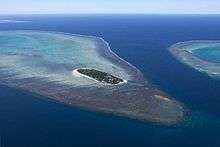
- Heron Island – the Heron Island Research Station is situated on Heron Island, 72 kilometres (45 mi) north-east of Gladstone. Its primary use is for coral reef ecology research and teaching and is an integral component of the Great Barrier Reef Ocean Observations System and the national Integrated Marine Observing System. It consists of more than 30 buildings on a two hectare lease.[119]
- Moreton Bay – the Moreton Bay Research Station and Study Centre is in Dunwich on North Stradbroke Island and researches the ecosystems.[120]
- Mt Nebo – the University of Queensland operates an International Seismograph Station on Mt Nebo.[121]
- Charters Towers – the University of Queensland operates an International Seismograph Station at Charters Towers.[122]
- Dayboro – the Dayboro Veterinary Surgery was bought by the university in 1987 as a teaching clinic for fifth year veterinary students in their dairy cattle medicine rotation. Later, separate brick accommodation was built for student accommodation. Research projects into practical aspects of dairy production are frequently carried out by clinic staff. There is a full range of veterinary services and pet care for dogs, cats, horses, cows, alpacas, goats, and all manner of other small and large animals.

Library
University of Queensland Library was founded in 1910. It developed from a small provincial university library into a major research library.[123] It consists of 12 branches.[124][125]
- Architecture and Music Library (ARMUS)
- Biological Sciences Library
- Central Library
- Dorothy Hill Engineering and Sciences Library (DHESL)
- Duhig Tower
- Fryer Library
- Gatton Library (J.K. Murray Library)
- Herston Health Sciences Library
- UQ/Mater McAuley Library
- Pharmacy Australia Centre of Excellence Health Sciences Library (PACE)
- Rural Clinical School Library (RCS)
- Walter Harrison Law Library
Transport and other amenities
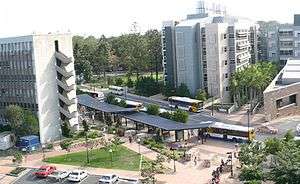
The university is served by the University of Queensland ferry wharf, the westernmost stop and terminus of the CityCat service. TransLink also operates two bus stations on campus: the University of Queensland bus station at Chancellor's Place in the west, connecting passengers to Brisbane's inner west suburbs such as Indooroopilly, Toowong and Milton; and the UQ Lakes busway station in the east, the western terminus of the Eastern Busway, with services to Brisbane's inner south suburbs such as Woolloongabba, Carindale and Mount Gravatt via the Eleanor Schonell Bridge. This bridge also allows pedestrians and cyclists to cross the Brisbane River, to reach Dutton Park. The closest stops of the Queensland Rail City network are the Toowong railway station, Park Road railway station, and Dutton Park railway station.
There are 3 refectories that provide food for students. These are the Main Refectory in the Student Union Complex, the Biological Sciences Refectory under the Biological Sciences Library, and the Physiology Refectory under the Physiology Lecture Theatres.[126] The Student Union Complex houses the Student Union and other student services.
Publishing
University of Queensland Press publishes academic works, as well as, non-fiction works and has launched the careers of noted authors.
Academic Journals
The University publishes several academic journals through its various schools and faculties and in association with publishers:
- Australian Journal of Indigenous Education[127]
- Australian Journal of Politics and History[128]
- Crossroads: an Interdisciplinary Journal for the Study of History, Philosophy, Religion and Classics[129]
- LAWASIA Journal[130]
- npj Science of Learning (in partnership with Springer Nature)[131]
- Queensland Archaeological Research (1984–2011, now published by JCU)[132]
- Queensland Historical Atlas[133]
- University of Queensland Law Journal[134]
Notable alumni and faculty
UQ has produced numerous distinguished alumni. Several notable examples include recipient of a Nobel Prize in Physiology and Medicine Peter C. Doherty,[135] recipient of the "Triple Crown of Acting" (having won Primetime Emmy, Tony and Academy Awards) Geoffrey Rush, triple Grammy Award-winning musician Tim Munro,[136] former Chief Justices of Australia Sir Gerard Brennan and Sir Harry Gibbs, international not-for-profit 'Hear and Say' founder and officer of the order of Australia Dimity Dornan, Principal of King's College London Edward Byrne, singer and eurovision representative Dami Im, former CEO of Dow Chemical Andrew N. Liveris, the first female Governor-General of Australia Dame Quentin Bryce, former Singaporean Minister of Defence and Manpower Lee Boon Yang, consecutive Olympic gold medal-winning swimmer David Theile, highly cited epidemiologist Graham Colditz, international best-selling author Kate Morton,[137] and CEO of MS Research Australia and Harvard Club of Australia fellow, Dr Matthew Miles.[138]
Controversies
Inequality
Australian Government survey data of university graduates has indicated in the past that students who enter the University of Queensland come from higher income families, and that graduates largely have higher paid occupations or positions of influence, prompting claims of elitism and social division.[139][140]
Relationship with the Government of China
Apparent links with the Government of China have led UQ to be embroiled in controversy. Four courses offered at the University have been partially funded the Chinese government. Other courses have been developed with the Confucius Institute, a Chinese government-supported international education partnership program. One of the courses, Understanding China, allegedly has content that conflates Uyghurs and the Hong Kong protestors with terrorism.[141]
Drew Pavlou expulsion
In 2019-2020, the university's close ties to the Chinese government became a matter of controversy when expulsion proceedings were begun against Drew Pavlou, a student and UQ Senator at the university, who had previously been involved in organising a protest at the university in support of the 2019–20 protest movement Hong Kong. The University alleges that this was due to harassment and bullying on the part of Pavlou, whilst Pavlou alleges that the proceedings are an attempt to silence criticism of the University and protect apparent financial links to the Chinese Government.[142]
Sexual assaults
Between 2011 and 2016 there were 38 officially reported cases of sexual assault and harassment on campus, resulting in 1 expulsion and 2 one week suspensions. This included a report in 2015 where a staff member "filmed someone in the shower. Police laid charges and the perpetrator’s casual employment at UQ was discontinued."[143] These figures are lower than the 2017 Australian Human Rights Commission report on sexual assault and harassment which found reported figures higher than this.[144] The vice-chancellor responded "there is no place for sexual assault or sexual harassment at UQ. Such behaviour is never the victim’s fault, and it will not be tolerated here" and committed UQ to introduce a number of new initiatives to address problems.[145]
Divestment
The University of Queensland's investment portfolio is a subject of ongoing debate. A fossil fuel divestment campaign began in 2013, led by the student group Fossil Free UQ and supported by the climate advocacy group 350.org. The goal of the campaign is "to freeze all new investments and phase out all current investments in coal, petroleum and gas over the next five years because fossil fuels drive climate change".[146]
On 18 April 2016, students occupied the Vice-Chancellory stating, 'We are asking the university to remove investment from the top 200 most polluting companies in the world' and calling for greater transparency regarding University investments.[147][148] The sit-in resulted in communication with the Vice-Chancellor in May 2016.[149]
In October 2016 Fossil Free QUT provided a report to the University Senate. For the period July 2015 to June 2016 direct fossil fuel companies comprised an average of 3.82% of UQ's $169.2m investment portfolio.[150] The University Senate voted not to divest from fossil fuels citing, 'that divestment would make no real difference'.[150][151]
In September 2013 350.org Australia released a report 'Exposing The Ties' to show 'shows how key decision makers at some of the country's leading tertiary institutions including the University of Queensland, University of Newcastle and University of New South Wales are non-executive directors or former employees of fossil fuel companies including AGL, BHP and Rio Tinto.'[152] This showed The University of Queensland received $31million from the Australian Coal Association Research Program (ACARP) and the University's Senate includes three non-executive directors of Senex Energy, Metro Mining and Queensland Investment Corporation, (owner of Epic Energy and Lochard Energy) and a former Queensland Resources Council board member and recipient of the Queensland Resources Council Medal.[152]
Seven of the 22 members of the senate for UQ have interests in the fossil fuel industry, having ties with fossil fuel companies previously or currently.[153]
In October 2017 ten students occupied the Chancellor's Office deeming the 2016 Senate vote on divestment illegitimate due to conflicts of interest.[153] The students were removed by the Queensland Police Service.
References
- "History of the University seal – About UQ". Uq.edu.au. Archived from the original on 12 November 2016. Retrieved 12 November 2016.
- "Annual Report 2018" (PDF). The University of Queensland. Archived (PDF) from the original on 23 September 2019. Retrieved 23 September 2019.
- (PDF) https://www.uq.edu.au/about/docs/annualreport/annual-report-19/2019UQAnnualReport_KeyStats.pdf. Missing or empty
|title=(help) - "UQ fast facts". The University of Queensland. Archived from the original on 19 January 2018. Retrieved 26 November 2019.
- "McDonnell International Scholars Academy". Archived from the original on 4 August 2019. Retrieved 4 August 2019.
- Thomis, Malcolm I. (1985). A place of light & learning : the University of Queensland's first seventy-five years (PDF). St. Lucia, Qld.: University of Queensland Press. p. 429. ISBN 9780702217975.
- "World Rankings Australian University". UniversityRankings.com.au. Retrieved 10 May 2020.
- "McDonnell International Scholars Academy". Global. Archived from the original on 4 August 2019. Retrieved 4 August 2019.
- "The University of Queensland". Global. Archived from the original on 4 August 2019. Retrieved 4 August 2019.
- "Schools and Partners". edX. Archived from the original on 14 November 2016. Retrieved 12 November 2016.
- https://shorthand.uq.edu.au/changemakers/issue3/sky-the-limit/
- https://www.chemeng.uq.edu.au/dowcsei/about
- https://www.abc.net.au/news/2020-06-05/coronavirus-covid-19-vaccine-csl-uq-cepi/12324596
- "Magnetic Resonance Imaging pioneer honoured". UniQuest. 15 June 2012. Archived from the original on 3 March 2017. Retrieved 12 November 2016.
- https://www.uq.edu.au/olympic-studies/content/olympians-uq
- "Queensland Rhodes Scholars". Archived from the original on 10 April 2019. Retrieved 31 March 2019.
- "University of Queensland Medical School (entry 601167)". Queensland Heritage Register. Queensland Heritage Council. Retrieved 6 July 2013.
- "FIRST GRADUATES". Trove. Retrieved 12 October 2016.
- Katie Hunt (30 April 2013). "World's oldest experiment ready for a drop of excitement". CNN. Archived from the original on 22 February 2014. Retrieved 6 July 2013.
- "Something's missing in our lives…and is set to make a comeback". UQ News. Retrieved 10 September 2018.
- "WOMAN FIRST SCIENCE DOCTOR AT VARSITY – The Courier-Mail (Brisbane, Qld.: 1933–1954) – 18 June 1942". Trove. Retrieved 12 October 2016.
- "UQ celebrates 5000th PhD graduate". UQ News. Archived from the original on 12 October 2016. Retrieved 12 October 2016.
- "Emmannel College Scheme – Townsville Daily Bulletin (Qld.: 1907–1954) – 20 March 1953". Trove. Retrieved 12 October 2016.
- "Remarks by President Obama at the University of Queensland". White House. 15 November 2014. Archived from the original on 10 November 2016. Retrieved 12 November 2016.
- "History of UQ – About UQ – The University of Queensland, Australia". Uq.edu.au. Archived from the original on 17 October 2016. Retrieved 12 October 2016.
- "2010 Queensland Greats recipients". Queensland Government. Archived from the original on 31 May 2017. Retrieved 31 May 2017.
- "UQx". 12 November 2013. Archived from the original on 19 February 2017.
- "THE UNIVERSITY OF QUEENSLAND ORGANISATION" (PDF). Uq.edu.au. August 2016. Archived (PDF) from the original on 15 December 2016. Retrieved 12 November 2016.
- "About the Senate – Senate – The University of Queensland, Australia". 20 May 2013. Archived from the original on 20 May 2013. Retrieved 30 May 2017.CS1 maint: BOT: original-url status unknown (link)
- "About UQ, Principal Officers of the University of Queensland". 26 June 2006. Archived from the original on 26 June 2006. Retrieved 30 May 2017.CS1 maint: BOT: original-url status unknown (link)
- "Academic Board". Uq.edu.au. 13 March 2013. Archived from the original on 14 November 2016. Retrieved 12 November 2016.
- "Funds help push University of Queensland up the global rankings". The Australian. 16 August 2016. Retrieved 23 February 2017.
- "Global experiences - Careers and Employability - University of Queensland". employability.uq.edu.au. Retrieved 1 July 2020.
- "QS World University Rankings 2021". Quacquarelli Symonds Limited.
- "World University Rankings 2020". TSL Education Limited.
- "Academic Ranking of World Universities 2019". Shanghai Ranking Consultancy.
- "U.S. News and World Report Best Global Universities Rankings". U.S. News and World Report.
- "CWTS Leiden Ranking 2017". Centre for Science and Technology Studies, Leiden University.
- "THE 2020 - Australia". Times Higher Education.
- "Academic Ranking of World Universities 2019 - Australia". Shanghai Ranking Consultancy.
- "U.S. News and World Report Best Global Universities in Australia/New Zealand". U.S. News and World Report.
- "Australian University Rankings". Australian Education Network.
- QS Subject Area Rankings 2020, archived from the original on 4 March 2020, retrieved 4 March 2020
- THE Rankings by Subject 2020, archived from the original on 1 March 2020, retrieved 28 February 2020
- "U.S. News Best Global Universities Ranking". U.S. News & World Report. Archived from the original on 3 November 2018. Retrieved 5 March 2020.
- "ARWU World University Rankings 2019 – Shanghai Ranking". shanghairanking.com. Archived from the original on 15 August 2017. Retrieved 6 March 2018.
- "QS World University Rankings". Top Universities. 11 June 2020. Archived from the original on 17 September 2012. Retrieved 11 June 2020.
- "World University Rankings 2018". Times Higher Education. Archived from the original on 6 September 2017. Retrieved 14 April 2020.
- "University of Queensland". UniversityRankings.ch. The State Secretariat for Education, Research and Innovation and swissuniversities. Archived from the original on 30 October 2016. Retrieved 17 January 2017.
- "JCU surprise package in Leiden ranking". The Australian. 19 May 2016. Retrieved 14 January 2017.
- (CWTS), Centre for Science and Technology Studies. "CWTS Leiden Ranking". CWTS Leiden Ranking. Archived from the original on 13 October 2019. Retrieved 28 May 2018.
- "Scimago Institutions Rankings". scimagoir.com. Retrieved 6 January 2020.
- "2016 MBA & Business School Rankings". The Economist. Archived from the original on 16 October 2016. Retrieved 12 November 2016.
- "Innovation can be learned, says University of Queensland's new MBA director". 31 March 2017. Archived from the original on 8 August 2017. Retrieved 6 March 2018.
- "Life sciences 2017". Times Higher Education. Archived from the original on 14 November 2016. Retrieved 12 November 2016.
- "Academic Ranking of World Universities in Life and Agriculture Sciences – 2016 | 2016 Top 100 Universities in Natural Sciences and Mathematics". Shanghairanking.com. Archived from the original on 20 November 2016. Retrieved 12 November 2016.
- "ARWU World University Rankings by Subject 2019". Archived from the original on 6 April 2020. Retrieved 19 April 2020.
- "Academic Ranking of World Universities in Life and Agriculture Sciences – 2016 | 2016 Top 100 Universities in Natural Sciences and Mathematics". cwur.org. Archived from the original on 22 May 2017. Retrieved 29 May 2017.
- "::: RANKINGS BY SUBJECT – 2017 | CWUR". cwur.org. Archived from the original on 22 May 2017. Retrieved 29 May 2017.
- "::: METHODOLOGY". cwur.org. Archived from the original on 27 May 2017. Retrieved 29 May 2017.
- "QS World University Rankings by Subject 2020". Archived from the original on 4 March 2018. Retrieved 6 March 2018.
- "Agriculture / Forestry". March 2020. Archived from the original on 4 March 2020. Retrieved 17 November 2019.
- "Environmental studies". March 2020. Archived from the original on 4 March 2020. Retrieved 17 November 2019.
- "Sports related subjects". March 2020. Archived from the original on 4 March 2020. Retrieved 17 November 2019.
- McNeil C (April 2006). "Who invented the VLP cervical cancer vaccines?". J. Natl. Cancer Inst. 98 (7): 433. doi:10.1093/jnci/djj144. PMID 16595773.
- "Queensland takes the lead on cancer research". Australian Cancer Research Foundation. Archived from the original on 13 September 2009. Retrieved 20 July 2009.
- "UQ researchers gain international recognition". Uq.edu.au. Archived from the original on 14 March 2016. Retrieved 12 October 2016.
- "Excellence in Research for Australia 2012" (PDF). Archived from the original (PDF) on 20 January 2013. Retrieved 10 December 2016.
- "Nature Index: Australia". Nature. 519 (7544): S64–S65. 2015. doi:10.1038/519S64a. PMID 25806697.
- "Research at UQ". Archived from the original on 4 May 2013. Retrieved 11 May 2017.
- CSIRO. "St Lucia, Queensland Biosciences Precinct". Archived from the original on 18 February 2017.
- "Centre for Advanced Imaging". Centre for Advanced Imaging - University of Queensland. Retrieved 23 July 2020.
- "Boeing opens research centre at UQ". Archived from the original on 4 March 2018. Retrieved 6 March 2018.
- "The Dow Chemical Company and University of Queensland sign groundbreaking $10 million strategic partnership". Archived from the original on 4 March 2018. Retrieved 6 March 2018.
- "Brisbane Diamantina Health Partners". Archived from the original on 10 June 2017. Retrieved 30 May 2017.
- "About UniQuest". UniQuest. Archived from the original on 3 December 2016. Retrieved 12 November 2016.
- "Student Centre – The University of Queensland, Australia". Archived from the original on 19 February 2017.
- "UQ Sport". UQSport.com. Archived from the original on 19 October 2016. Retrieved 12 November 2016.
- "Athletics Centre". UQ Sport. Archived from the original on 25 January 2014. Retrieved 12 November 2016.
- "Fitness Centre". UQ Sport. Archived from the original on 4 February 2014. Retrieved 12 November 2016.
- "Tennis Centre". UQ Sport. Archived from the original on 4 February 2014. Retrieved 12 November 2016.
- "UQ Playing Fields & Ovals – UQ Sport, Brisbane". 3 April 2011. Archived from the original on 3 April 2011. Retrieved 30 May 2017.CS1 maint: BOT: original-url status unknown (link)
- https://uqsport.com.au/clubs
- "Three Minute Thesis – The University of Queensland, Australia". Archived from the original on 19 February 2017.
- "Young meets old for UQ tradition – UQ News". Uq.edu.au. Archived from the original on 20 May 2013. Retrieved 12 November 2016.
- "2010 Great Court Race – UQ Events". Uq.edu.au. 12 May 2010. Archived from the original on 30 June 2017. Retrieved 12 November 2016.
- www.nbm.com.au, New Business Media -. "About". Archived from the original on 19 February 2017.
- https://orientation.uq.edu.au/event/market-day-st-lucia
- "UQ Careers Fair – UQ Events, The University of Queensland". Uq.edu.au. 30 March 2011. Archived from the original on 30 June 2017. Retrieved 12 November 2016.
- "Students build biggest engineering careers expo – UQ News". Uq.edu.au. Archived from the original on 20 May 2013. Retrieved 12 November 2016.
- "Union College (entry 602504)". Queensland Heritage Register. Queensland Heritage Council. Retrieved 16 November 2014.
- "Archived copy". Archived from the original on 15 May 2013. Retrieved 15 March 2012.CS1 maint: archived copy as title (link)
- "Other campuses and facilities – The University of Queensland, Australia". Uq.edu.au. 12 July 2013. Archived from the original on 6 April 2016. Retrieved 12 November 2016.
- "Campuses and Locations – About UQ". Uq.edu.au. 8 January 2015. Archived from the original on 12 November 2016. Retrieved 12 November 2016.
- "25 Of The Most Beautiful College Campuses In The World". Buzzfeed.com. 4 February 2013. Archived from the original on 19 November 2016. Retrieved 12 November 2016.
- "10 most beautiful universities, Australia". Times Higher Education. 12 February 2018. Archived from the original on 1 November 2018. Retrieved 2 November 2018.
- Readshaw, Grahame; Ronald Wood (1987). Looking up looking back at old Brisbane. Bowen Hills, Queensland: Boolarong Publications. p. 62. ISBN 978-0-86439-032-5.
- "University of Queensland, Great Court Complex (entry 601025)". Queensland Heritage Register. Queensland Heritage Council. Retrieved 6 July 2013.
- "The University of Queensland Art Museum". Archived from the original on 30 April 2019. Retrieved 30 April 2019.
- "About us – UQ Art Museum". Artmuseum.uq.edu.au. Archived from the original on 9 November 2016. Retrieved 12 November 2016.
- "Antiquities Museum – The University of Queensland, Australia". Uq.edu.au. 26 October 2012. Archived from the original on 4 November 2016. Retrieved 12 November 2016.
- "About Us – Antiquities Museum". Uq.edu.au. 31 December 2015. Archived from the original on 13 October 2016. Retrieved 12 November 2016.
- "UQ Anthropology Museum – The University of Queensland, Australia". anthropologymuseum.uq.edu.au. Archived from the original on 28 May 2017. Retrieved 30 May 2017.
- "About – Gatton CampusAustralia". Uq.edu.au. 16 September 2016. Archived from the original on 15 August 2016. Retrieved 12 November 2016.
- Robinson, Penny (1 September 2008). "UQ Gatton becomes hub of animal research". UQ News Online. Archived from the original on 29 May 2012. Retrieved 21 June 2012.
- "UQ Marks-Hirschfeld Museum". Brisbane Living Heritage Network. Archived from the original on 6 March 2018. Retrieved 15 June 2017.
- "Marks-Hirschfeld Museum of Medical History", Trove, 2009, retrieved 15 June 2017
- "UQ-Ochsner medical program". University of Queensland. Archived from the original on 16 February 2017. Retrieved 30 January 2017.
- Trounson, Andrew (21 July 2014). "USQ to make a go of UQ underused Ipswich campus". The Australian. Retrieved 8 May 2015.
- "Archived copy". Archived from the original on 6 October 2009. Retrieved 2 November 2009.CS1 maint: archived copy as title (link)
- "a cultural, educational and heritage facility of the University of Queensland". Customs House. Archived from the original on 20 October 2016. Retrieved 12 November 2016.
- Finney's Hill United Silver Mines Limited. Reports and Statement of Accounts for Year ended 30 June 1924. Registered Office: Commerce House, Adelaide Street, Brisbane. 1924.
- White FTM. The Queensland University Experimental Mine. Paper No 128, Vol 6, pp 1103–12, Proceedings – General, published by Eighth Commonwealth Mining and Metallurgical Congress, 1965. 399 Little Collins St., Melbourne, Vic., Aust.
- Notes from University of Queensland Department of Mining and Metallurgical Engineering. Queensland Government Mining Journal (1958).
- White FTM. Mining and Metallurgical Education....the Role of the University of Queensland. Queensland Government Mining Journal. July 1963.
- "About JKMRC". University of Queensland. Archived from the original on 11 July 2016. Retrieved 11 July 2016.
- "Julius Kruttschnitt". University of Queensland. Archived from the original on 14 September 2016. Retrieved 11 July 2016.
- "Archived copy". Archived from the original on 20 July 2008. Retrieved 22 August 2008.CS1 maint: archived copy as title (link)
- "MBRS About Us – Science Research Facilities – The University of Queensland, Australia". 20 February 2011. Archived from the original on 20 February 2011. Retrieved 30 May 2017.CS1 maint: BOT: original-url status unknown (link)
- "UQ Seismological Observatory". quakes.uq.edu.au. Archived from the original on 28 February 2020. Retrieved 3 December 2019.
- "CTAO Charter's Towers, Australia". FDSN Station Book. Archived from the original on 20 September 2019. Retrieved 3 December 2019.
- East, John W.: A Brief History of the University of Queensland Library, 2006.
- "Libraries – About UQ – The University of Queensland, Australia". Uq.edu.au. 10 May 2011. Archived from the original on 18 April 2012.
- "UQ Library Location & Hours". library.uq.edu.au. Archived from the original on 3 April 2020. Retrieved 12 April 2020.
- "UQ Maps – The University of Queensland, Australia". uq.edu.au. Archived from the original on 30 June 2017. Retrieved 1 July 2017.
- "The Australian Journal of Indigenous Education". Cambridge Core. Archived from the original on 23 May 2019. Retrieved 13 April 2020.
- "Australian Journal of Politics & History". Wiley Online Library. Archived from the original on 22 December 2019. Retrieved 13 April 2020.
- "Crossroads: An interdisciplinary journal for the study of history, philosophy, religion and classics". uq.edu.au. Archived from the original on 30 August 2019. Retrieved 13 April 2020.
- "LAWASIA Journal". law.uq.edu.au. 12 May 2016. Archived from the original on 28 October 2019. Retrieved 13 April 2020.
- "About the Journal | npj Science of Learning". Nature. Archived from the original on 13 May 2017. Retrieved 13 April 2020.
- "Queensland Archaeological Research". journals.jcu.edu.au. Archived from the original on 7 March 2020. Retrieved 13 April 2020.
- "Queensland Historical Atlas |". www.qhatlas.com.au. Archived from the original on 26 February 2020. Retrieved 13 April 2020.
- "The University of Queensland Law Journal". law.uq.edu.au. 12 May 2016. Archived from the original on 28 October 2019. Retrieved 13 April 2020.
- "A Key Experiment". Nobel Foundation. Archived from the original on 12 March 2017. Retrieved 12 November 2016.
- "Australian Tim Munro wins his third Grammy". Skynews.com.au. 16 February 2016. Archived from the original on 7 April 2016. Retrieved 12 November 2016.
- Williams, Sue (20 October 2012). "The Interview: Kate Morton". The Sydney Morning Herald. Archived from the original on 2 November 2016. Retrieved 31 March 2017.
- "News Release: Dr Matthew Miles, CEO, MS Research Australia – one of two Non-Profit Fellowship Recipients". Archived from the original on 8 August 2018. Retrieved 2 November 2018.
- Department of Education Training and Youth Affairs (1998), The Characteristics and Performance of Higher Education Institutions, Canberra: Higher Education Division, Department of Education, Employment and Youth Affairs
- Department of Education Training and Youth Affairs (1999), Completions, Undergraduate academic outcomes for the 1992 commencing students, Melbourne: DETYA.
- "Aussie uni teaching 'pro-China class' funded by Beijing agency". NewsComAu. 3 July 2020. Retrieved 3 July 2020.
- Patrick, Aaron (26 May 2020). "University risks making Drew Pavlou a free speech martyr". Financial Review. Retrieved 27 May 2020.
- Funnell, Nina (10 October 2016). "Full list of universities exposed by sexual assault investigation". News Limited. Archived from the original on 2 August 2017. Retrieved 1 August 2017.
- "Unis urged to act as 'shocking' survey reveals half of all students face sexual harassment". ABC News. 1 August 2017. Archived from the original on 8 August 2017. Retrieved 13 August 2017.
- "Message from the Vice-Chancellor". Archived from the original on 14 August 2017. Retrieved 6 March 2018.
- "Interview: Fossil Free UQ". Milaana Open. 26 May 2015. Archived from the original on 10 October 2017. Retrieved 10 October 2017.
- "Students Escalate Demand For Universities To Drop Fossil Fuel Investments – New Matilda". New Matilda. 19 April 2016. Archived from the original on 10 October 2017. Retrieved 10 October 2017.
- Mitchell-Whittington, Amy (18 April 2016). "Students protest for UQ to divest in fossil fuels". Brisbane Times. Archived from the original on 11 October 2017. Retrieved 10 October 2017.
- "UQ meets Fossil Free UQ group". UQ News. Archived from the original on 10 October 2017. Retrieved 10 October 2017.
- "Chancellor's letter to Fossil Free UQ". UQ News. Archived from the original on 10 October 2017. Retrieved 10 October 2017.
- "UQ resolves not to divest from fossil fuels". UQ News. Archived from the original on 10 October 2017. Retrieved 10 October 2017.
- "RIGHT NOW: Join us to #ExposeTheTies". Fossil Free Australia. Archived from the original on 2 August 2019. Retrieved 10 October 2017.
- "UQ students protest fossil fuel divestment +more Zedlines". 4ZZZ Brisbane 102.1FM. 10 October 2017. Archived from the original on 10 October 2017. Retrieved 10 October 2017.
Further reading
- Thomis, Malcolm I. (1985). A place of light & learning : the University of Queensland's first seventy-five years (PDF). St. Lucia, Qld.: University of Queensland Press. p. 429. ISBN 9780702217975.
External links
| Wikimedia Commons has media related to University of Queensland. |

